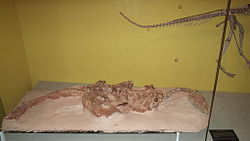Guaibasaurid
| Guaibasaurids Temporal range: Late Triassic, 231.4–208 Ma |
|
|---|---|
 |
|
| Fossil skeleton of Guaibasaurus candelariensis | |
| Scientific classification | |
| Kingdom: | Animalia |
| Phylum: | Chordata |
| Class: | Reptilia |
| Clade: | Dinosauria |
| Order: | Saurischia |
| Suborder: | †Sauropodomorpha |
| Family: |
†Guaibasauridae Bonaparte et al., 1999 |
| Type species | |
|
†Guaibasaurus candelariensis Bonaparte et al., 1999 |
|
| Subgroups | |
|
|
Guaibasauridae is a family of primitive saurischian dinosaurs, known from fossil remains of late Triassic period formations in Brazil and Argentina.
The exact makeup and classification of the Guaibasauridae remains uncertain. The family was originally named by Jose Bonaparte and colleagues in 1999 to contain a single genus and species, Guaibasaurus candelariensis. When a second specimen of Guaibasaurus was described from better remains in 2007, it became easier to compare it to other enigmatic early saurischians, which are often difficult to classify because they combine characteristics of the two major saurischian groups, Theropoda and Sauropodomorpha. Bonaparte and colleagues, in light of the information gained from this second specimen, found that the genus Saturnalia (which is anatomically very similar to Guaibasaurus) could also be assigned to the Guaibasauridae, though they did not conduct a phylogenetic analysis or define Guaibasauridae as a clade. The researchers also tentatively assigned the poorly understood genus Agnosphitys to this family. However, the latter assignment was not supported by the results of the phylogenetic analyses of early dinosaurs that were carried out by Baron, Norman & Barrett (2017).
Bonaparte and colleagues (2007) found that guaibasaurids have more characteristics in common with theropods than they do with early sauropodomorphs (or "prosauropods"). Because of this, according to Bonaparte, they are most likely either a very basal group on the stem leading toward sauropodomorphs, or a group ancestral to both sauropodomorphs and theropods. Furthermore, the authors interpret this as evidence that the common ancestor of both saurischian lineages was more theropod-like than prosauropod-like.
...
Wikipedia
